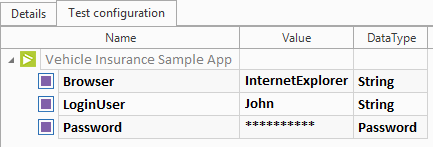Create test configuration parameters
All objects for which you can create test configuration parameters have an additional tab Test configuration in the details view.
-
Select Create Test configuration parameter from the mini toolbar or press Ctrl + N, Ctrl + C of the chosen object type.
The object level where the parameter has been created is displayed in bold. Objects which inherit this parameter are displayed in the usual format.
-
Assign a user-specific name and a value to the test configuration parameter. In the Value column, you can specify any text or regular expression (see chapter "Regular expressions").
If you want to hide the value in the Value column, you can select Password in the DataType column. This masks the value with an asterisks *. If you then change the DataType to String the value in the Value column will be deleted. The values are saved encrypted too.

Test configuration parameter for running tests in Internet Explorer
You can change any existing test configuration parameter by entering a new Name, Value or DataType.
For information on the different types of test configuration parameters you can create, see chapter "Test configuration parameters".
Use test configuration parameters in a TestCase
If you define a test configuration parameter, it is automatically applied to different areas, as for instance with the Browser test configuration parameter in the example above.
To use test configuration parameters in a TestCase, you can link the test configuration parameter directly to the TestStepValue using the following dynamic expression:
|
Syntax: |
{CP[<Test configuration parameter name>]} |
Test configuration parameters - context menu
Reset test configuration parameters to default value
To reset the value of the test configuration parameter, follow the steps below:
Click on the test configuration parameter and select Reset to default value from the context menu.

Reset the value of a test configuration parameter
If you adapted an inherited test configuration parameter, the value is reset to the parameter's default value (parent element). If the configuration parameter is the same as the parent element, the value will be deleted.
Translate value
For further information on the option Translate value, see chapter "Verifying dynamic values".